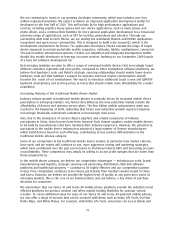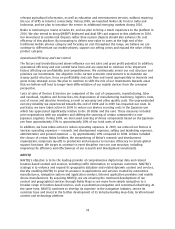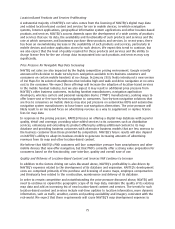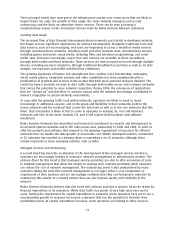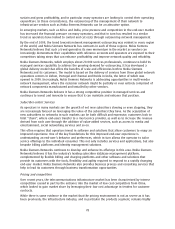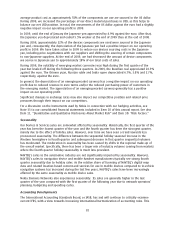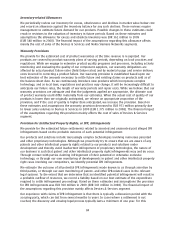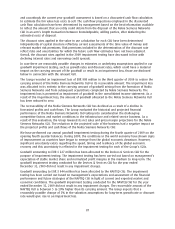Nokia 2009 Annual Report Download - page 81
Download and view the complete annual report
Please find page 81 of the 2009 Nokia annual report below. You can navigate through the pages in the report by either clicking on the pages listed below, or by using the keyword search tool below to find specific information within the annual report.competitive and subject to price erosion. The pricing environment remained intense in 2009 and is
expected to remain so in 2010.
Nokia Siemens Networks’ net sales are impacted by those pricing developments, which show some
regional variation, and in particular by the balance between sales in developed and emerging
markets. While price erosion was evident across most geographical markets, it was particularly
intense in a number of emerging markets where many operator customers have been subject to
financial pressure, both through lack of availability of financing facilities during 2009 as well as
intense pricing pressure in their domestic markets.
Pricing pressure is evident in the traditional products markets, in particular, where competitors may
have products with similar technological capabilities, leading to commoditization in some areas.
Nokia Siemens Networks ability to compete in these markets is determined by its ability to remain
competitive with its rivals in the area of price and it is therefore important for the company to
continue to lower product costs to keep pace with price erosion. Nokia Siemens Networks achieved its
targets for reducing product costs in 2009, and will need to continue to do so in order to provide its
customers with highquality products at competitive prices. There is currently less pricing sensitivity
evident in the managed services market, where vendor selections are also determined by the level of
trust and demonstrated capability in the field.
Outlook, targets and priorities for 2010
The general conditions that prevailed in 2009, in which the telecommunications infrastructure
industry contracted as operators delayed or curtailed spending in response to economic concerns, are
expected to stabilize in 2010. Nokia Siemens Networks expects the pricing and competitive
environment to remain intense in 2010, and therefore estimates that the mobile and fixed
infrastructure and related services market will be flat in euro terms in 2010, compared to 2009.
Nokia Siemens Networks’ performance in the infrastructure business is determined by its ability to
satisfy the competitive and complex requirements of the market and its current and potential
customers. Nokia Siemens Networks will need to continue to leverage and, in some cases, improve its
scale, technology and product portfolio to maintain or improve its position in the market. We target
for Nokia Siemens Networks to grow faster than the market in 2010, compared to 2009, primarily due
to improved product competitiveness and continued momentum in services.
There are several factors that drive the profitability at Nokia Siemens Networks. First, there are the
drivers of net sales discussed above. In addition, the scale, operational efficiency and cost control
have been and will continue to be important factors affecting Nokia Siemens Networks’ profitability
and competitiveness. Nokia Siemens Networks’ product costs are comprised of the cost of
components, manufacturing, labor and overhead, royalties and license fees, the depreciation of
product machinery, logistics costs as well as warranty and other quality costs. Nokia Siemens
Networks’ profitability is also impacted by the pricing environment, product mix and regional mix.
In November 2009, Nokia Siemens Networks announced a reorganization of its business structure to
align it better to customer needs. At the same time, Nokia Siemens Networks announced a plan to
improve its financial performance and increase its profitability. The plan includes targeted reductions
of annualized operating expenses and production overheads of EUR 500 million by the end of 2011,
compared to the end of 2009, excluding special items and purchase price accounting related items.
Nokia Siemens Networks also announced in November 2009 that as part of that effort, the company
is conducting a global personnel review which may lead to headcount reductions in the range of
about 7% to 9% percent of its approximately 64 000 employees. Nokia Siemens Networks estimated
that total charges associated with these reductions will be in the range of EUR 550 million to be
recorded mainly over the course of 2010. In addition to the operating expense and production
overhead savings, Nokia Siemens Networks announced that it will target an annual reduction in
product and service procurement costs related to cost of goods sold that is substantially larger than
the targeted EUR 500 million in operating expenses and production overhead reductions. Nokia
79






